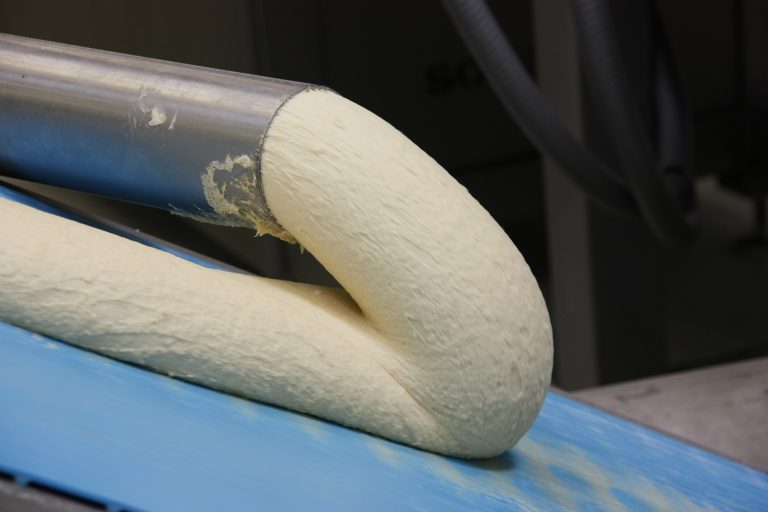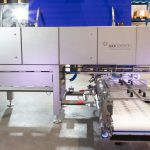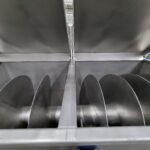Batch mixing has been the mixing technology of choice for many years. However, the increasing food and quality demand shed more light on the negative effects related to batch mixing. As a result, more and more food producers are looking for new ways to increase throughput and consistency and find that in continuous dough mixing. Check out below 5 reasons to go for continuous mixing and learn which mixing technology suits your production process best.
1. Automation
Continuous mixing is a fully automated mixing technology including the continuous weighing of each of the ingredients. The liquid and solid ingredients are brought into contact via the homogenizer (phase 1 mixing) and enter the continuous mixer (phase 2 mixing) as a blend of ingredients. In the continuous mixer, controlled mechanical energy is applied to the mix of ingredients. Depending on the amount of energy required to correctly develop your product, the dough is discharged after a few minutes.
The process from continuously feeding the ingredients until homogeneously mixing the final dough is a fully automated process. There is no labor involved meaning the product quality is independent of the operator.
2. Constant consistency
The biggest benefit of continuous is definitely product quality consistency. With batch mixing, there are many opportunities for inconsistencies to kick in. For example, an operator may not accurately dose the ingredients or the dough may not be evenly hydrated.
Also, when on a batch mixer one batch is finished, the other one is being produced. This means that after each batch cycle the dough has to wait before being further processed. While dough is a living entity, waiting means that the dough characteristics start to change. In time, dough gets a higher temperature due to the interactions of the seperate ingredients. Also, als a result of proofing, dough gets a lower density in time. These dough variations between each batch cycle are also called ‘the head and the tail‘ of batch mixing.
On a continuous mixing system, each piece of dough has the same age going through the process. Besides that, there is no need for the dough to wait before being further processed. This prevents undesirable variations from batch to batch allowing your mixer to produce consistent finished weight, size and texture.
Check out this news item concluding that the constant consistency related to continuous mixing also improves your oven performance.
3. Process control
On a continuous mixing system, all ingredients are loaded by machine. This increases accuracy and supports food safety. Above all, it stimulates quality traceability as the system measures and controls what has been dosed every split second. This data can be stored for quality purposes. The dosing stations are configured to the recipe forming the set value formulation. Different recipes can be produced on one and the same system.
Wheares on a batch mixer you increase mixing time to create a higher product development; on a continuous mixer you increase the RPM of the mixing tools. This allows you to run a variety of different products on one at the same continuous mixing system.
4. Lower cost of ownership
As a result of the high automation grade; the initial investment of a continuous mixing system is generally higher. Nevertheless, continuous mixing has a lower cost of ownership. The complete operation is automated meaning you save significant labor costs. Besides that, the constant consistent dough quality with continuous mixing allows for less product waste during production. Also, as the dough comes out as a continuous stream of product there is no need to buy additional machinery to resize the batches.
5. Smaller footprint
A batch mixer is limited in its throughput capabilities. Even a batch mixer that can process 2.500 kg per hour can only handle a certain amount of batches per hour. Besides that, time is lost in between each batch. To increase production, you have to install another batch mixer in time. This makes that when your production is growing, there comes a point where it is uneconomical to produce batch.
Continuous mixers generally replace a variety of batch mixers as they can produce up to 12.000 kg of dough per hour (on one and the same mixer). With that they can feed a variety of different make-up lines. As long as ingredients keep being dosed, the mixer will keep mixing and discharging a continuous stream of dough.





